This Pozole blanco or white pozole is a must-make for your next holiday or special celebration. Tender hominy and chunks of pork meat simmered in a flavorful concoction of aromatics and spices, then served with your favorite toppings.
Pozole blanco, or white pozole, is a Mexican traditional soup made of hominy, pork meat, and a flavorful seasoning prepared with garlic, onions, herbs, and spices.
This type of pozole is mostly found in states like Guerrero, Colima, and Michoacan. Other types of this soup like pozole rojo (red) or pozole verde (green) are popular in other states.
Blanco means white in Spanish, and as the name suggests, pozole blanco is characterized by its clear or white broth. The broth is typically clear because it doesn’t contain the rich red chili sauce that gives pozole rojo its color.
However, white pozole is still delicious and one of the most traditional dishes from Mexico. It’s usually found at typical restaurants called cenadurías and the homemade recipe is a staple at special occasions like Christmas, Day of the Dead, weddings, and birthdays.
Ingredients
- Corn: I am using pre-nixtamalized corn, but feel free to substitute it with canned hominy.
- Pork meat: Traditionally, a combination of various cuts is best for this type of posole, so I am using pork belly, pork ribs, tenderloin, and pork skin. Make sure everything is cut into large chunks.
- Aromatics & spices: You’ll need a whole garlic knob, onion, bay leaves, oregano, cumin seeds, black peppercorns, and salt.
- Toppings: Lettuce, onions, radishes, dried oregano, lime wedges, tostadas, and salsa.
I’ve been making pozole blanco from a young age. My grandma and my mother owned a cenaduría in Colima and this was the star of the menu. This is my family’s authentic recipe and I am very proud to share it with you. So, let’s get started!
How To Make Pozole Blanco
Step 1. Make the Hominy
Place the dried corn into a large bowl and cover with 2 inches of water. Allow to soak overnight.
Next day in the morning, discard the soaking water and wash the corn thoroughly under cold water.
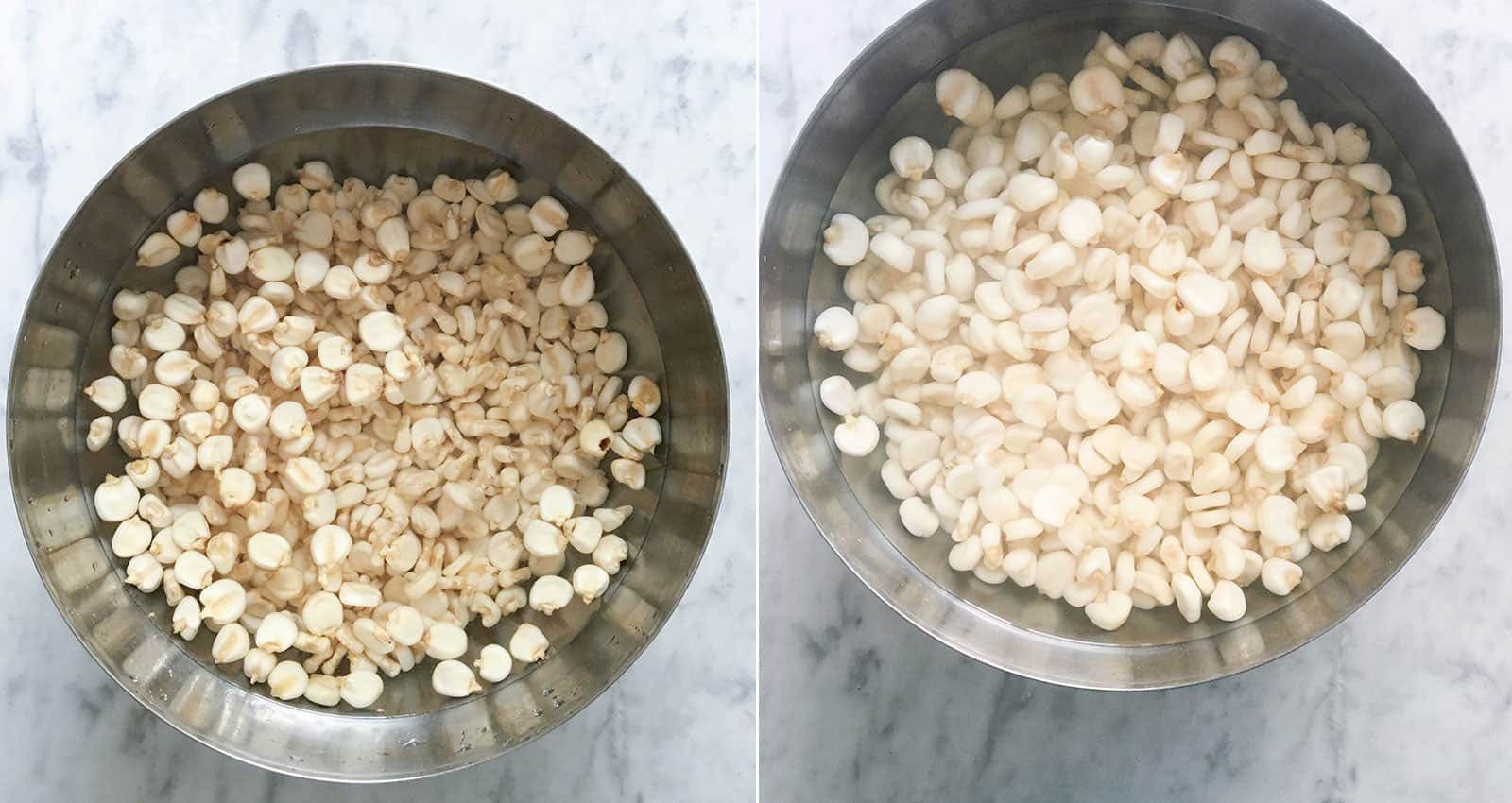
Discard the little brown “heads” on the corn by picking the little tips with your fingers and removing them.
Top Tip: Deheading corn kernels can be a bit time-consuming, but it’s an essential step to achieve the desired texture and flavor in authentic posole.
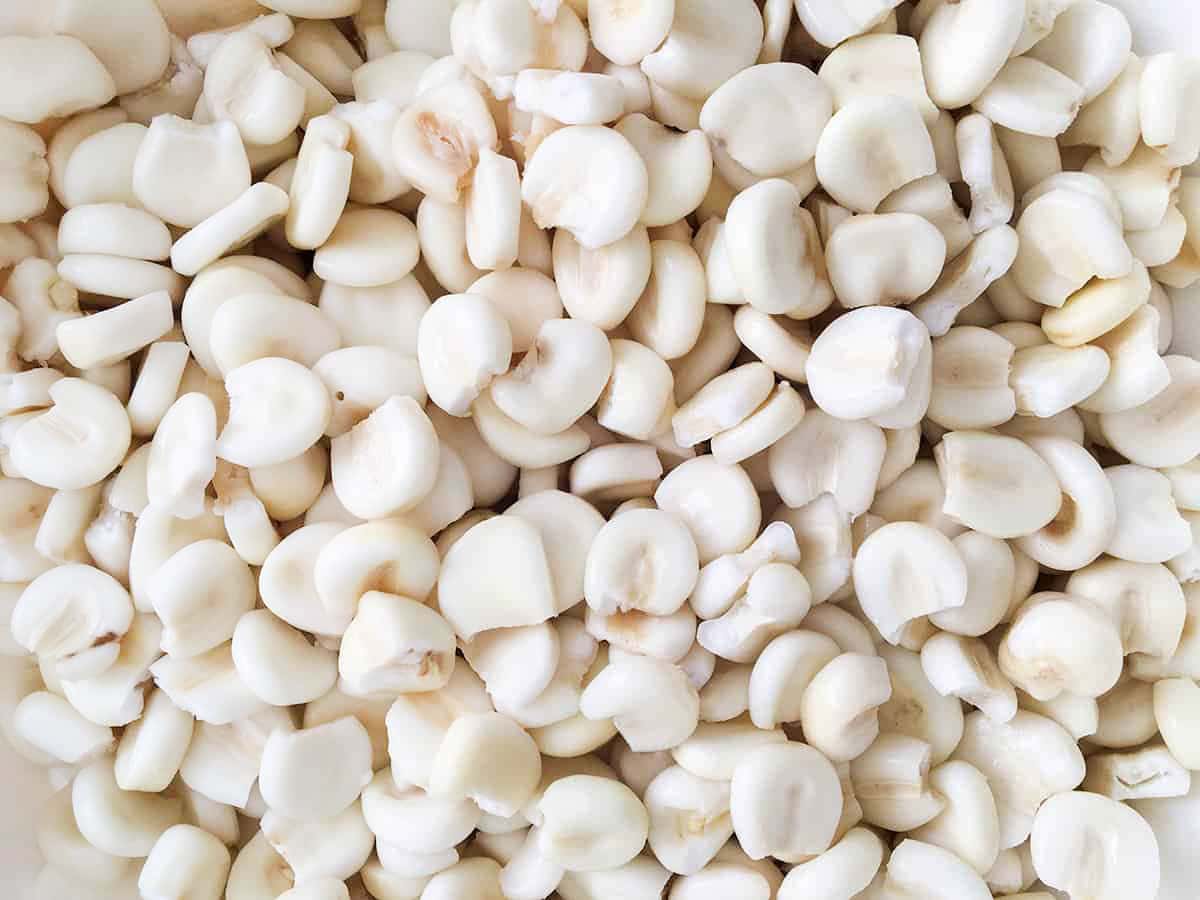
Place the corn in a large pot and cover it with 2 inches of water.
Cook for about 3 hours over medium heat, the time will depend on the type of corn you using.
Important note: If you want to use canned hominy, you can just rinse it with cold water and start the recipe from here.
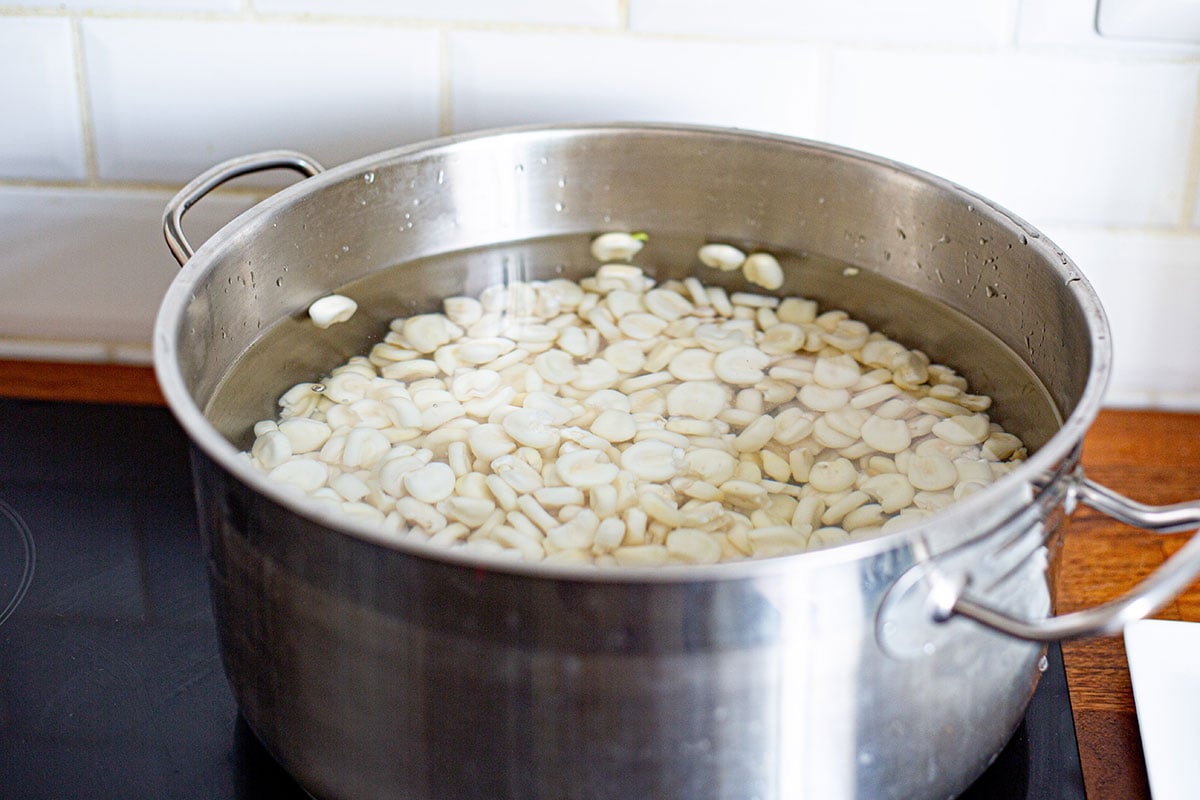
After three hours, the corn should start to bloom, like popcorn, and the cooking water will have a thick consistency.
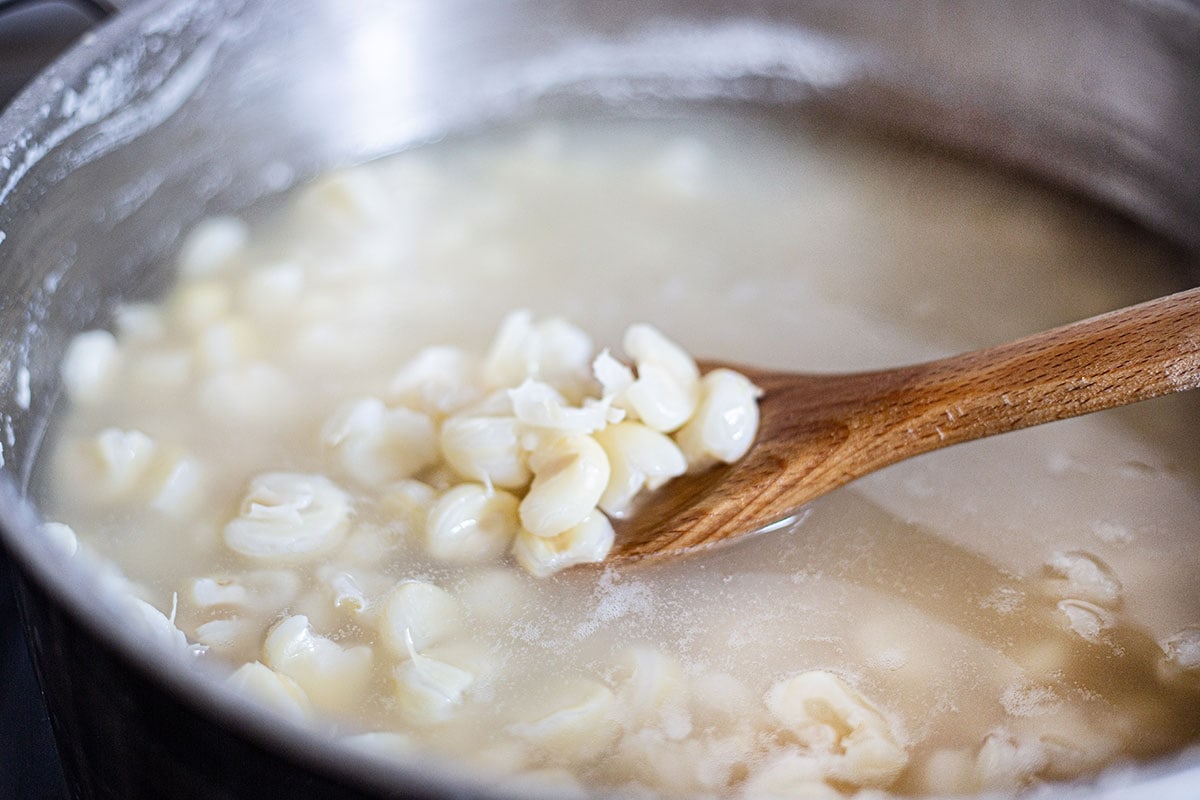
Step 2. Add Flavors & Meat
Place onion, garlic, cumin, black pepper, bay leaves, oregano, and 2 tablespoons of salt into a blender. Add 2 cups of water and blend for 3 minutes or until nicely combined.
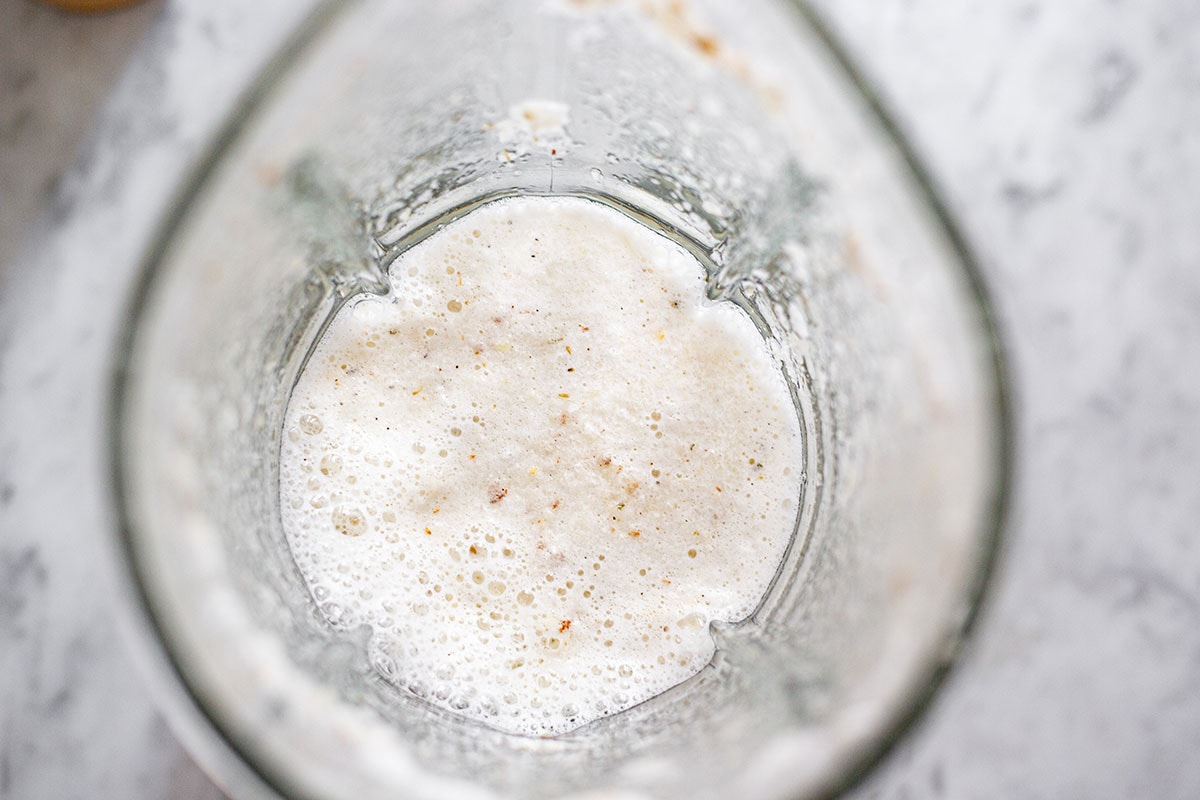
Strain the garlic and onion mixture into the pot and stir to combine.
Now, wash the meat with cold water and then add it to the pot. Use a large cooking spoon to submerge the meat into the corn mixture.
Make sure there’s enough liquid to cook the meat, so add more if necessary.
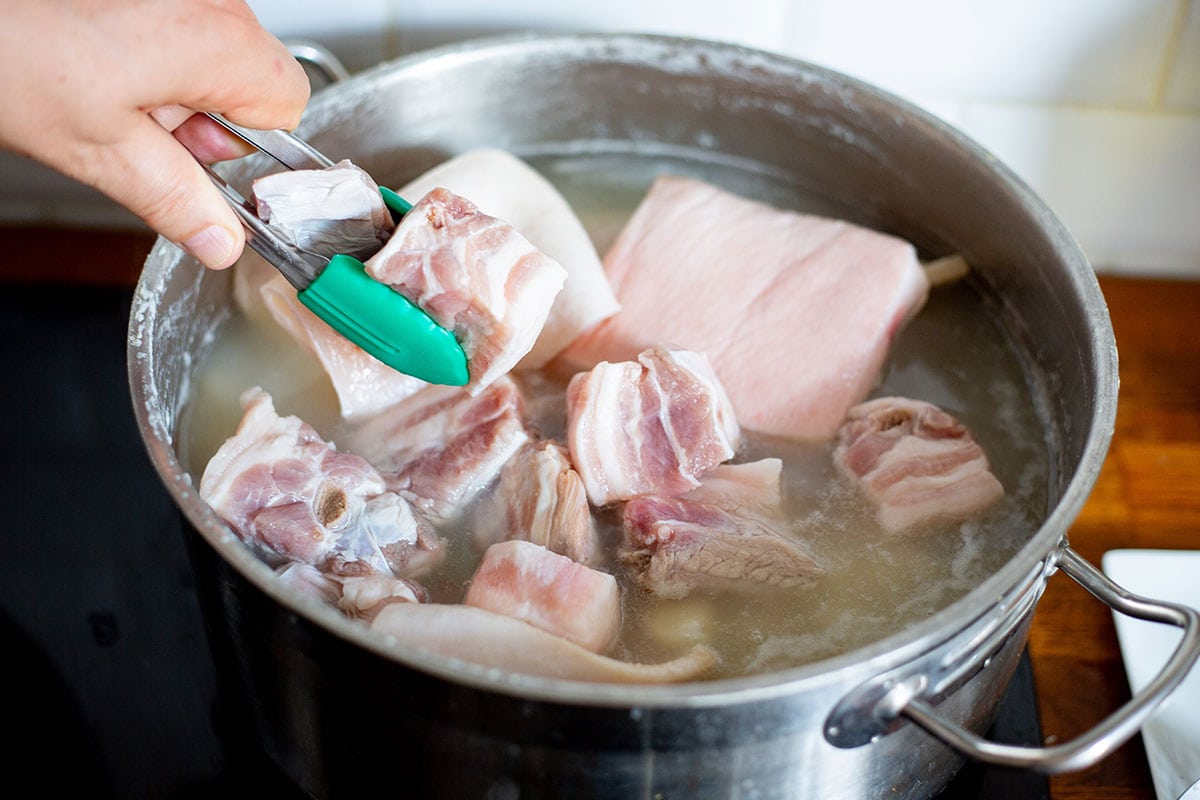
Step 3. Simmer all together
Cook from 2 to 3 hours over medium heat or until the meat and hominy are nicely tender. Adjust salt to taste.
Note: If the corn kernels still feel a bit hard after 3 hours, remove the meat and continue cooking until the kernels are soft.
Remove the meat carefully, place it in a container, and cover it with a clean kitchen towel.
Allow to cool down a bit and then cut it into small bite-sized pieces or shred it.
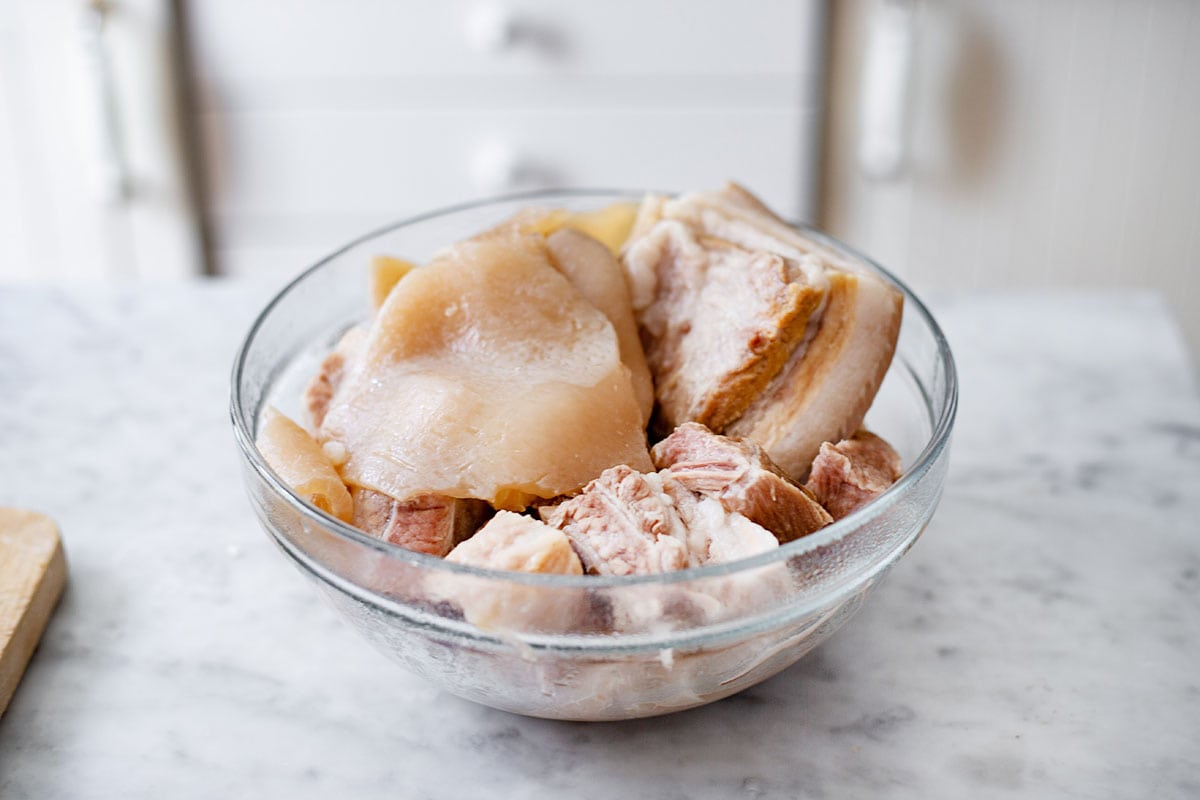
Serve your homemade pozole as suggested below.
Tips & Recipe Notes
- Soaking the corn is essential to soften the tips and remove them. Optionally, you can add a small amount of baking soda to the water.
- Use a pot large enough to contain the kernels which will expand while cooking, the meat, and plenty of broth.
- Adjust the consistency of the flavorful soup by adding more water or allowing it to cook until thickened to your liking. And remember to always adjust seasonings at the end of cooking.
- One of my grandma’s best tips for making pozole blanco with a delicious thick broth was to smash some of the kernels against the pot sides with a wooden spoon. This trick still works today!
How to Serve
Pozole blanco is typically served in a festive and customizable manner, allowing diners to tailor their bowls to their taste preferences. Here’s how is traditionally served:
- Add the hominy and plenty of broth to a deep plate.
- Top with shredded pork meat.
- Add lettuce, onions, radish slices, and oregano.
- Drizzle with salsa macha or salsa de cacahuate (both are the perfect fit for pozole).
- Last, add a squeeze of lime juice and enjoy along with tostada shells.
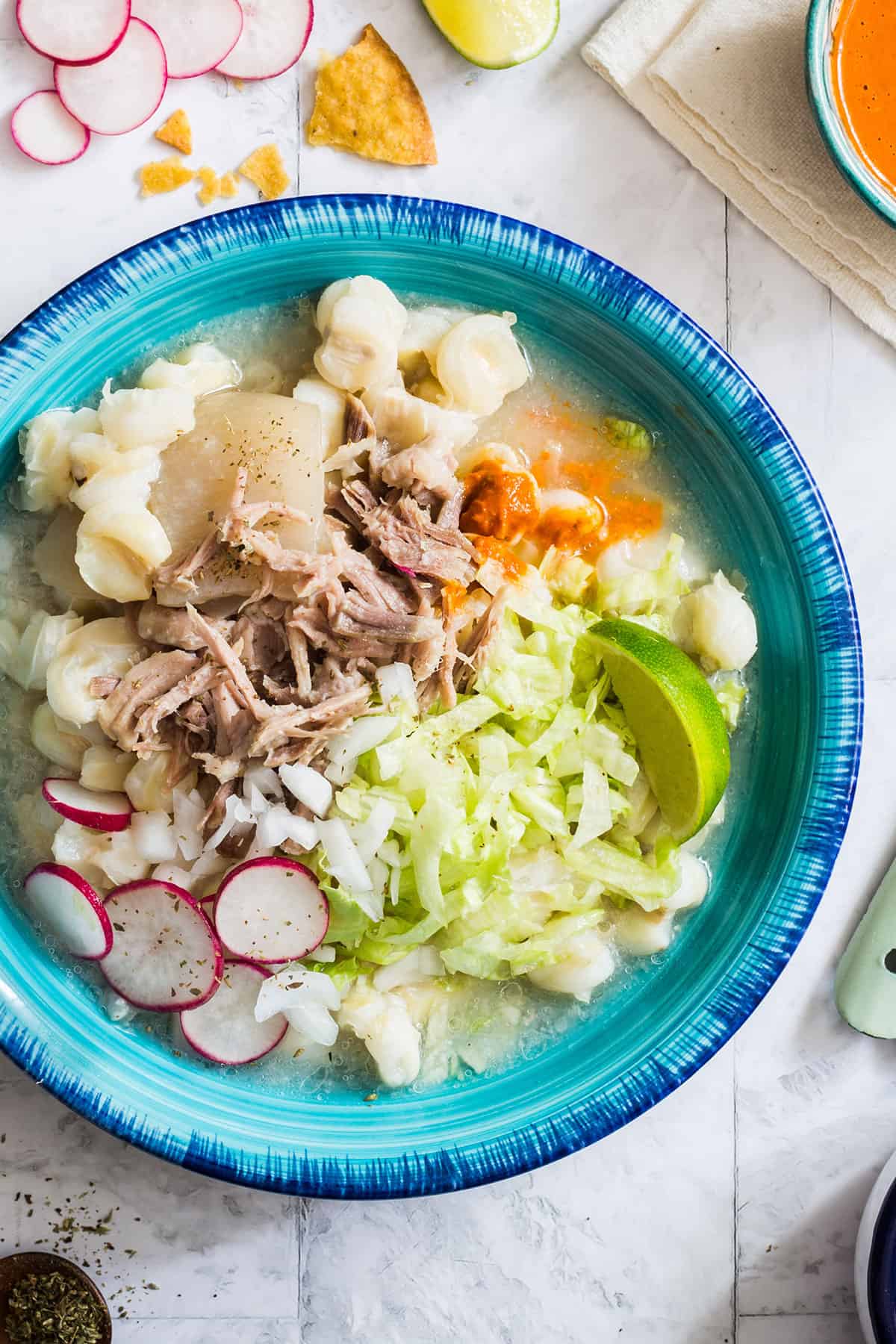
Store And Reheat
Pozole blanco can last up to 4-5 days in the refrigerator. Make sure to allow the soup to cool down completely, then transfer everything to a container and close it with a tight lid before storing.
You can also freeze the leftovers for up to 2-3 months. Then thaw overnight in the fridge.
When ready to enjoy again, add pozole soup to a pot with a splash of water or chicken stock, then reheat stirring occasionally.
FAQ
What are the different types of pozole soup?
Pozole has 3 popular variations which are rojo, verde, and blanco. Each has its own particular flavor based on the spices and seasonings used in the preparation. Rojo uses a combination of red chiles such as guajillo, ancho, and chile de árbol. Verde is made with a sauce from poblanos, jalapeños, and serrano chile. And blanco is made with no chiles or other spices that change the broth hue.
When did pozole originate?
The origins of pozole are deeply rooted in pre-Columbian Mexican history, dating back thousands of years before the arrival of Spanish conquistadores in the 16th century. Pozole is considered one of the oldest known dishes in Mexican cuisine and holds a significant place in the country’s culinary and cultural heritage.
More Mexican Traditional Soups
If you enjoyed this pozole blanco recipe, please take a minute and rate it below in the comments. Also, don’t forget to share and follow this blog on Instagram, Facebook, Pinterest, and YouTube.

Pozole Blanco (White Pozole)
Ingredients
- 2.2 pounds pre-nixtamalized cacahuazintle dried corn (or 3 pounds canned hominy)
- 2.2 pounds pork belly (cut into large chunks)
- 2.2 pounds pork tenderloin (cut into large chunks)
- 1.1 pounds pork ribs (cut in big pieces)
- 1.1 pounds pork skin (nicely cleaned and cut into large pieces)
- 1 medium white onion (cut into quarters)
- 1 knob garlic
- 1 teaspoon cumin seeds
- 1 teaspoon black peppercorns
- 2 bay leaves
- ½ teaspoons oregano
- salt (to taste)
for topping
- lettuce (shredded)
- onions (chopped)
- radishes (sliced)
- oregano
- limes
- Mexican chili oil
- tostada shells
Instructions
- Add the corn into a large bowl and cover with 2 inches of water. Allow to soak overnight (read note 1).
- Next morning, discard the soaking water and wash the corn thoroughly under cold water.
- Discard the little brown “heads” on the corn kernels by picking the little tips with your fingers and removing them (read note 2).
- Place the corn in a large pot and cover it with 2 inches of water.
- Cook for about 3 hours over medium heat, the time will depend on the type of corn you using.
- You'll notice that corn is ready for the next step when the kernels start to bloom, like popcorn.
- Place onion, garlic, cumin, black pepper, bay leaves, oregano, and 2 tablespoons of salt into a blender. Add 2 cups of water and blend for 3 minutes or until smooth.
- Strain the garlic and onion mixture into the pot and stir to combine.
- Wash the meat under cold water and add it to the pot. Use a large cooking spoon to submerge the meat into the corn mixture.
- Make sure there’s enough liquid to cook the meat, so add more if necessary.
- Cook for 2 to 3 hours over medium heat or until the meat and hominy are nicely tender (read note 3). Adjust salt to taste.
- Remove the meat carefully, place it in a container, and cover it with a clean kitchen towel.
- Allow to cool down a bit and then cut it into small bite-sized pieces or shred it.
Serve
- Add the hominy and plenty of broth to a deep plate. Top with shredded pork meat.
- Add lettuce, onions, radish slices, and oregano. Drizzle with salsa and a squeeze of lime juice. Enjoy it along with tostadas.
Notes
- If you want to use canned hominy, start the recipe from step 7.
- Deheading corn kernels can be a bit time-consuming, but it’s an essential step to achieve the desired texture and flavor in authentic pozole.
- If the meat is already cooked but the corn kernels are still a little hard, remove the meat and keep cooking the kernels until nicely tender.
- Make the broth thicker by allowing it to cook longer. You can also smash some of the kernels against the pot sides with a wooden spoon.


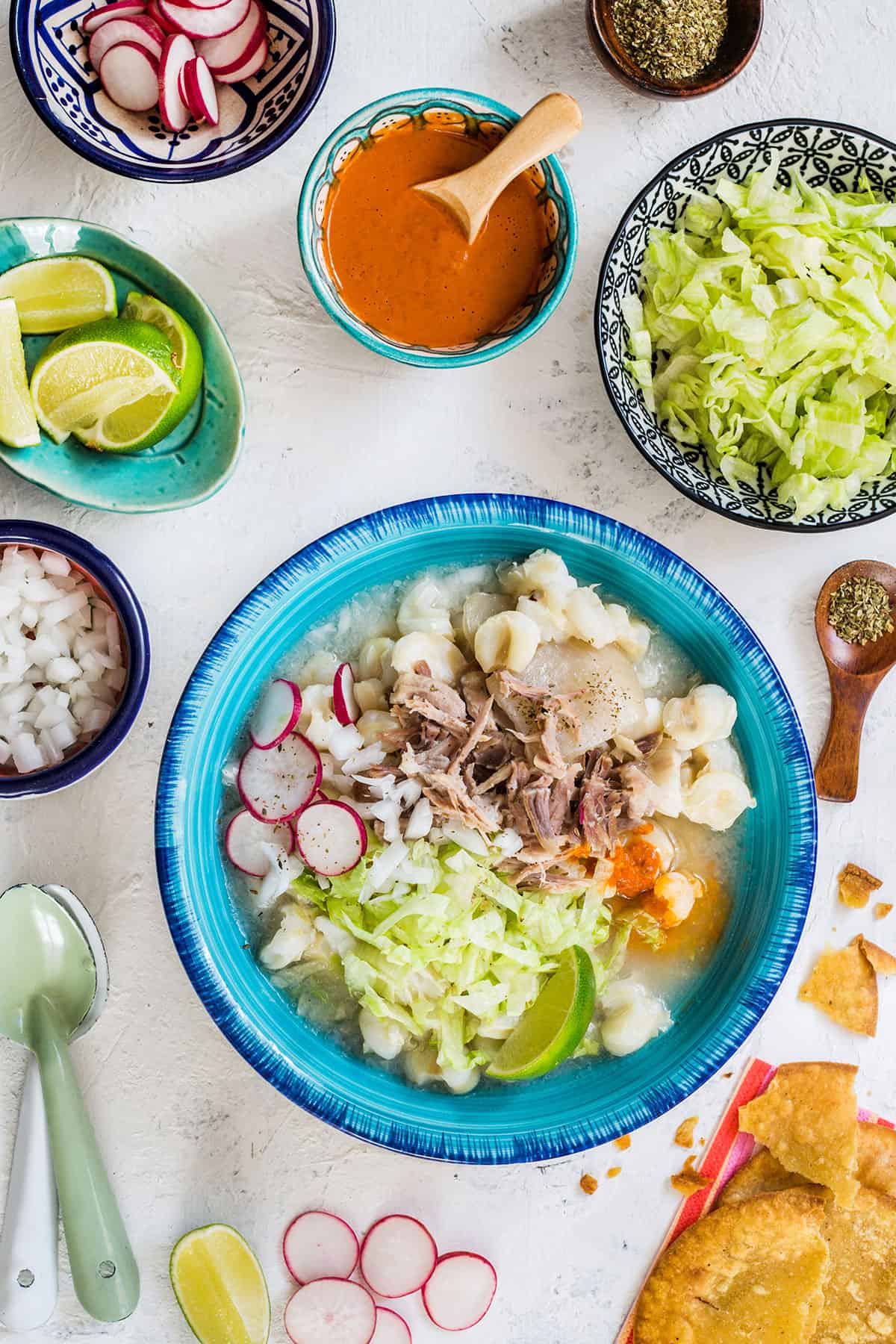
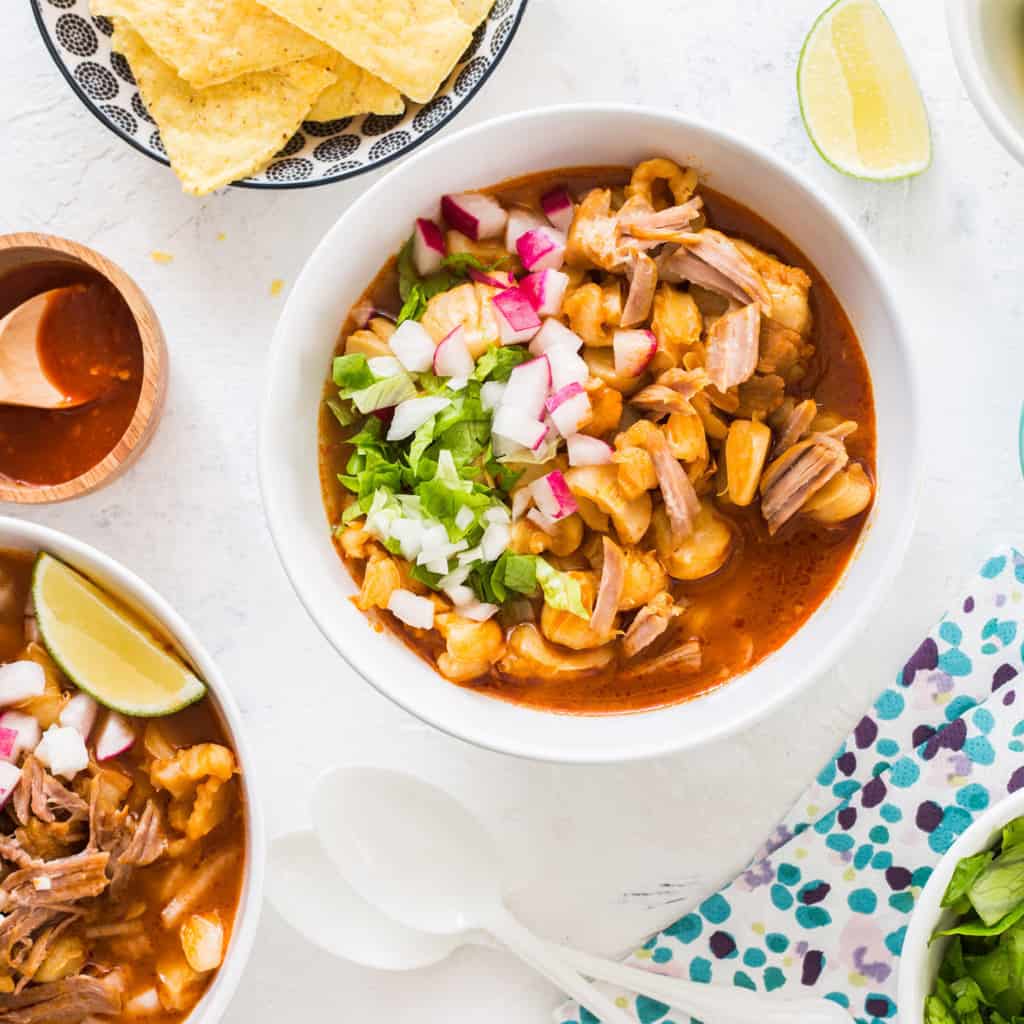
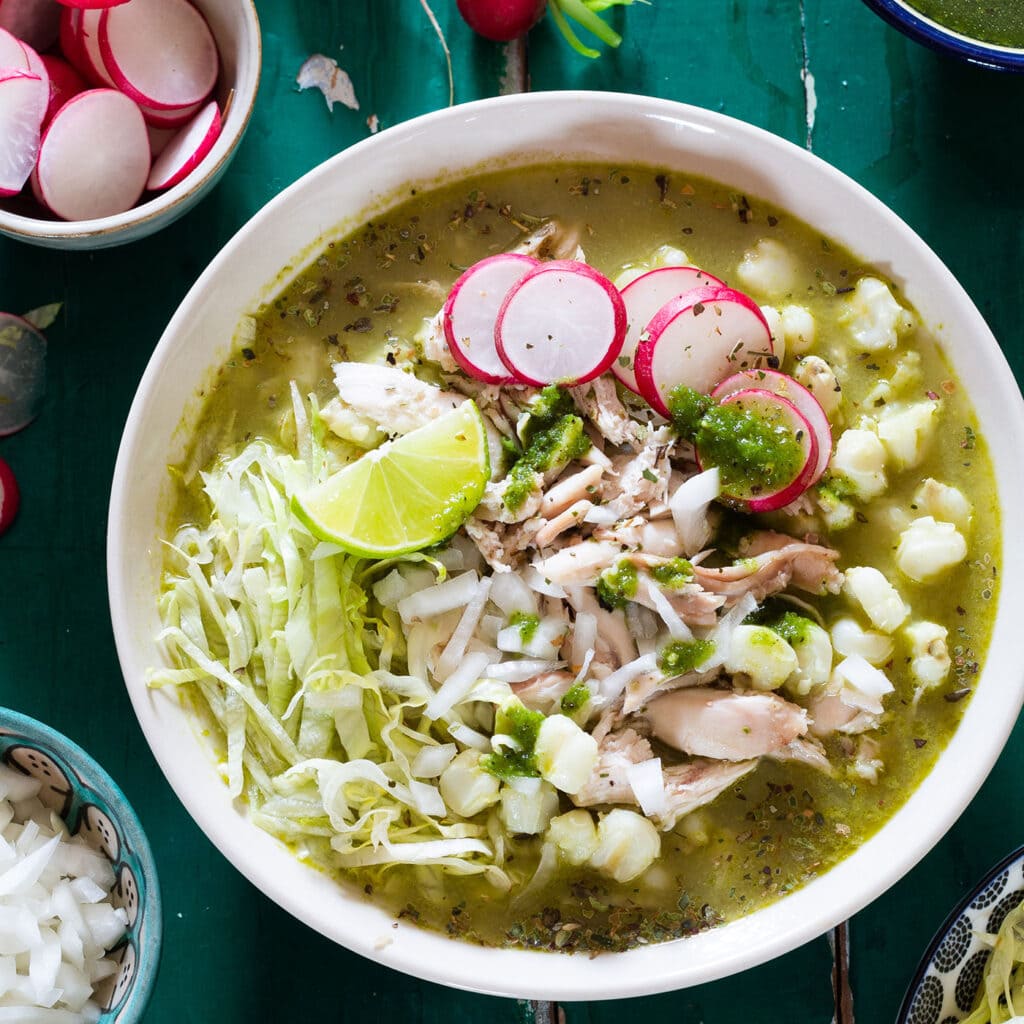
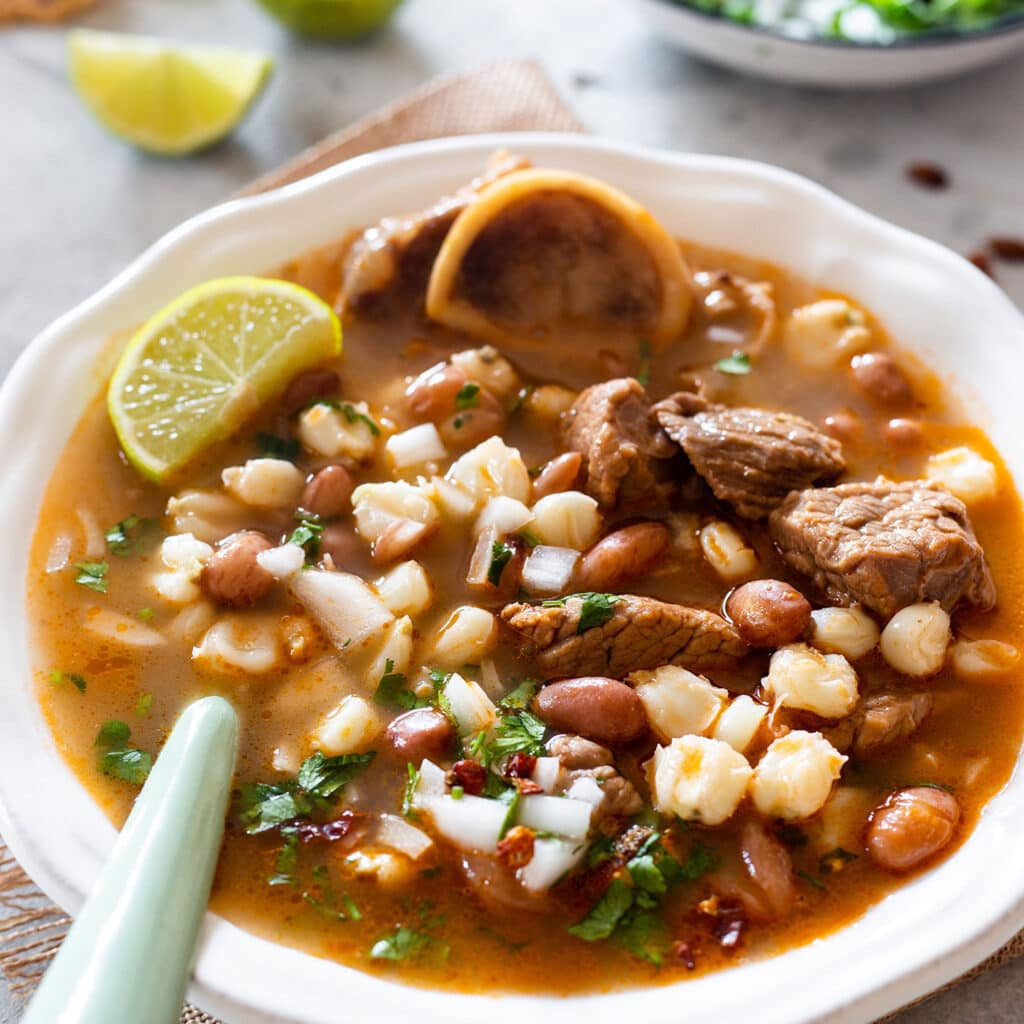
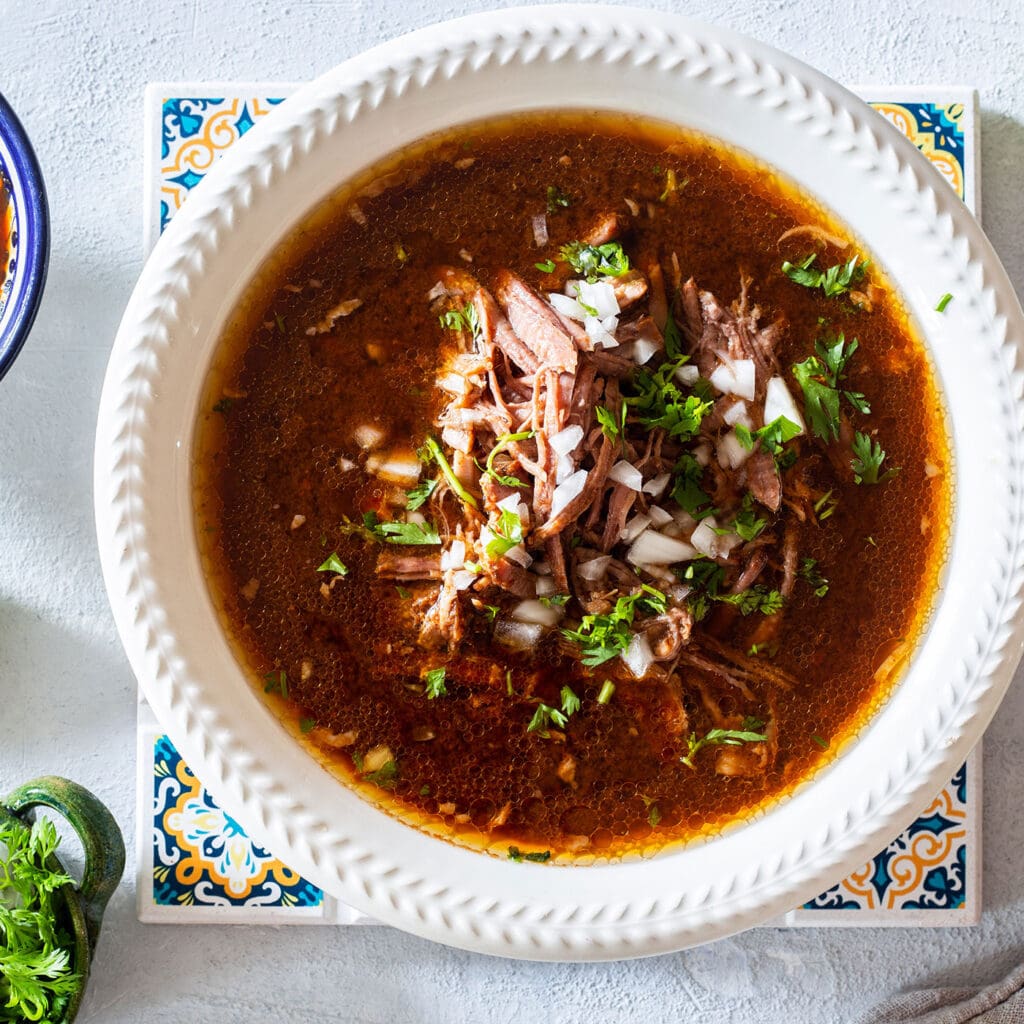


Thanks for sharing your family’s authentic recipe of this pozole blanco. My family loved it as well! It was so flavorful and comforting.
What amazing recipe and love all the history and stories in this post. Thanks for sharing!
I tried this today and it was DELISH!!! I’m gonna be making this so often!